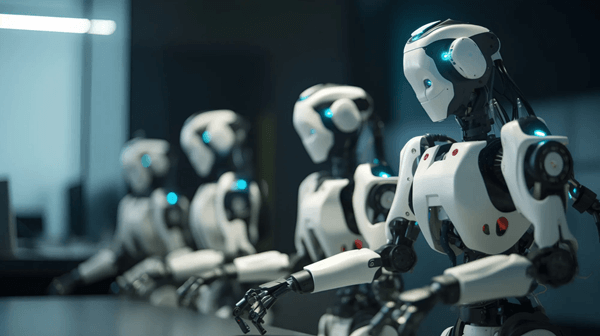Introduction
Robots Dot to Dot: The Revolution Through Nattapong’s Vision, The dawn of the 21st century has seen unprecedented advancements in technology, with robotics at the forefront of this evolution.
Among the many pioneers pushing the boundaries of what robots can achieve, Nattapong stands out as a visionary, weaving together the complex tapestry of robotics into a coherent and transformative vision. His work spans across various domains, bringing robots into everyday life in ways that were once confined to the realm of science fiction.
This article delves into the journey of Nattapong, his groundbreaking projects, and the profound impact his innovations have had on society. From enhancing industrial efficiency to revolutionizing healthcare and even redefining personal and domestic robotics, Nattapong’s contributions are both extensive and deeply influential.
Early Life and Inspirations
Nattapong’s fascination with robotics began at a young age. Born in a technologically vibrant era, he was captivated by the potential of machines to augment human capabilities. His early education was marked by a keen interest in mathematics and physics, laying a solid foundation for his future endeavors in robotics.
During his teenage years, Nattapong was particularly inspired by the works of Isaac Asimov and the futuristic visions portrayed in movies like “Star Wars” and “Blade Runner.” These cultural touchstones fueled his imagination, prompting him to pursue a career where he could turn these fictional ideas into reality.
Academic Pursuits and Initial Breakthroughs
Nattapong’s academic journey was as illustrious as it was rigorous. He pursued his undergraduate studies in Mechanical Engineering, where he developed a strong grasp of the principles that govern mechanical systems. His passion for robotics drove him to further his studies, obtaining a Master’s degree in Robotics Engineering.
During his postgraduate studies, Nattapong made his first significant breakthrough. He developed a novel algorithm for improving the accuracy and efficiency of robotic arms used in manufacturing. This innovation caught the attention of several leading tech companies, paving the way for collaborations that would define his career.
Pioneering Projects
1. Industrial Automation
Nattapong’s work in industrial automation has been revolutionary. He spearheaded the development of robotic systems that are now integral to modern manufacturing processes. His innovations include advanced robotic arms capable of performing complex tasks with unparalleled precision.
One of his most notable projects involved the creation of a robotic assembly line for the automotive industry. This system not only increased production efficiency but also significantly reduced the margin of error, leading to higher quality products and lower costs. Nattapong’s robots are equipped with machine learning algorithms, allowing them to adapt to new tasks and environments, further enhancing their utility in industrial settings.
2. Healthcare Robotics
Perhaps one of the most impactful areas of Nattapong’s work is in healthcare. He envisioned robots that could assist medical professionals and improve patient outcomes. His team developed a range of medical robots, from surgical assistants to rehabilitation devices.
One groundbreaking innovation is a robotic exoskeleton designed to aid in the rehabilitation of stroke patients. This device helps patients regain mobility by providing support and resistance during physical therapy exercises. The exoskeleton’s adaptive algorithms customize the therapy sessions to the individual needs of each patient, significantly speeding up recovery times.
Nattapong also pioneered the development of telepresence robots, which allow doctors to interact with patients remotely. These robots are equipped with cameras, microphones, and screens, enabling real-time consultations and examinations. This technology has been particularly beneficial in rural and underserved areas, where access to medical professionals is limited.
3. Domestic and Personal Robotics
In addition to his contributions to industry and healthcare, Nattapong has also made significant strides in bringing robots into our homes. He envisioned a future where robots would not only perform mundane tasks but also enhance our quality of life.
One of his most popular creations is a domestic robot designed to assist with household chores. This robot can clean, cook, and even provide companionship to its owners. Its advanced AI allows it to learn the preferences and routines of the household, making it an indispensable part of daily life.
Nattapong’s work in personal robotics also extends to educational tools. He developed a series of robots designed to teach children coding and robotics. These educational robots make learning fun and interactive, inspiring the next generation of engineers and innovators.
Ethical Considerations and Social Impact
While Nattapong’s work has undeniably transformed multiple industries, it also raises important ethical considerations. The widespread adoption of robots in various sectors has led to debates about job displacement and the role of automation in society.
Nattapong has been a vocal advocate for responsible robotics. He emphasizes the importance of designing robots that augment human capabilities rather than replace them. His vision includes a future where robots take on repetitive and dangerous tasks, allowing humans to focus on more creative and fulfilling work.
He also addresses concerns about privacy and security. With robots becoming an integral part of our lives, ensuring that these machines are secure from cyber threats is paramount. Nattapong’s designs incorporate robust security measures, including encryption and regular software updates, to protect users’ data and privacy.
The Future of Robotics Through Nattapong’s Lens
Looking ahead, Nattapong envisions a world where robots and humans coexist harmoniously, each complementing the other’s strengths. He believes that the next frontier for robotics lies in artificial intelligence and machine learning, which will enable robots to become even more adaptable and intelligent.
One of his ongoing projects involves the development of robots with advanced emotional intelligence. These robots are designed to understand and respond to human emotions, making them more effective in roles that require empathy and social interaction, such as caregiving and customer service.
Nattapong is also exploring the potential of robotics in environmental conservation. He is working on robots that can monitor and protect natural habitats, assisting in efforts to combat climate change and preserve biodiversity. These robots can perform tasks such as planting trees, monitoring wildlife, and cleaning up polluted areas.
Conclusion
Nattapong’s journey in the field of robotics is a testament to the transformative power of technology. His innovations have not only revolutionized industries but also enhanced the quality of life for countless individuals. From industrial automation to healthcare, and from domestic robots to ethical considerations, Nattapong’s work covers a broad spectrum, reflecting his comprehensive vision for the future of robotics.
As we move forward into an increasingly automated world, Nattapong’s contributions serve as a guiding light. His commitment to responsible innovation ensures that robots will continue to serve as valuable partners in our quest for progress and well-being. Through his pioneering work, Nattapong has not only connected the dots in the complex field of robotics but has also charted a path toward a future where technology and humanity thrive together.

